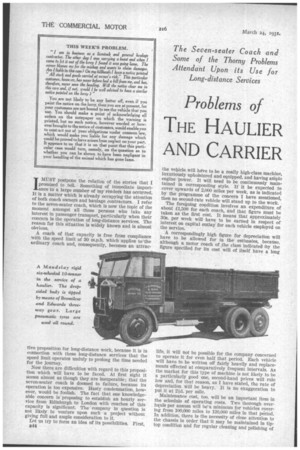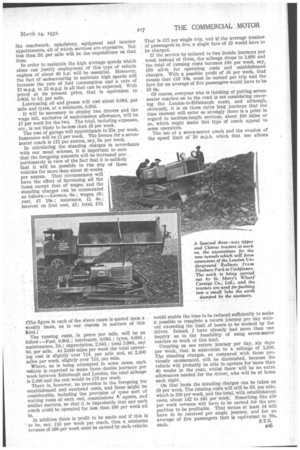Problems of
Page 62

Page 63

If you've noticed an error in this article please click here to report it so we can fix it.
THE HAULIER
AND CARRIER
IMUST postpone the relation of the stories that I promised to tell. Something of immediate importance to a large number of my readers has occurred. It is a matter which is already occupying the attention of both coach owners and haulage contractors. I refer to the seven-seater coach, which is now the topic of the moment amongst all those persons who take any interest in passenger transport, particularly when their concern is the operation of long-distance services. The reason for this situation is widely known and is almost obvious.
A coach of that capacity is free from compliance with the speed limit of 30 m.p.h. which applies to'the ordinary coach and, consequently, becomes an attrac
tire proposition for long-distance work, because it is in connection with these long-distance services that the speed limit operates unduly to prolong the time needed for the journey.
Now there are difficulties with regard to this proposition which will have to be faced. At first sight it seems almost as though they are insuperable; that the seven-seater coach is doomed to failure, because its operation is too expensive. Hasty condemnation, however, would be foolish. The fact that one knowledgeable concern is proposing to establish an hourly service from Edinburgh to London with coaches of this capacity is significant The ' company in question is not likely to venture upon such a project without giving full and ample consideration to it. Let us try to form an idea of its possibilities. First, B44 the vehicle will have to be a really high-class machine, luxuriously upholstered and equipped, and having aniple engine power. It will need to be continuously maintained in corresponding style. If it be expected to cover upwards of 2,000 miles per week, as is indicated by the programme of the concern I have mentioned, then no second-rate vehicle will stand up to the work. The forekoing condition involves an expenditure of about £1,500 for each coach, and that figure must he taken as the first cost. It means that approTimately 30s. per week will have to be earned in respect of interest on capital outlay for each vehicle employed on the service.
A correspondingly high figure for depreciation will have to be allowed for in theestimates, because, although a motor coach of the class indicated •by the figure specified for its cost will of itself have a long
life, it will not be possible for the company concerned to operate it for even half that period. Each vehicle will have to be written off fairly heavily and replacements effected at comparatively frequent intervals. As the market for this type of machine is not likely to be a particularly good one, second-hand prices will rule low and, for that reason, as I have stated, the rate of depreciation will be heavy. It is no exaggeration to put it at 2id. per mile.
Maintenance cost, too, will be an important item in the schedule of operating costs. Two thorough overhauls per annum will ben minimum for vehicles covering from 100,000 miles to 120,000 miles in that period. In addition, there is the necessity of close attention to the chassis in order that it may be maintained in tiptop condition and for regular cleaning and polishing of
the coachwork, upholstery, equipment and interior appointments, all of which services are expensive. Not less than 2d. per mile will be the,expenditure on that item.
In order to maintain the high average speeds which alone can justify employment of this type of vehicle engines of about 40 h.v will be essential. Moreover, the fact of endeavouring to maintain high speeds will increase the rate of fuel consumption and a rate of 12 m.p.g. to 15 m.p.g. is all that can be expected. With petrol at its present price, that is equivalent to 0.80d. to IA per mile.
Lubricating oil and grease will cost about 0.08d. per mile• and tyres, at a minimum, 0.60d.
It will be necessary to employ two drivers and the wage bill, exclusive of maintenance allowance, will be £7 per week for the two. The total, including expenses, etc., is not likely to be-less than £8 per week.
The cost of garage will approximate to 25s. per week.
• Insurance will be 11 per week. The licence for a sevenseater coach is £12 per annum, say, 5s. per week. In calculating the standing charges in accordance • with our usual scheme, it is important to note that the foregoing amounts will be increased proportionately in view of the fact that it is unlikely that it will be possible to run any of these vehicles for more than about 40 weeks per annum. That circumstance will have the effect of increasing all the items except that of wages, and the standing charges can be enumerated as follows :—Licence, 6s.; wages, £8; rent, £1 10s.; , insurance, £1 4s.; Interest on first cost, £2; total, £13.
(The figure in each of the above eases is quoted upon a weekly basis, as is our custom in matters of this kind.) The running costs, In pence per mile, will be as follow :—Fuel, 0.80d.; lubricants, 0.08d.; tyres, 0.60d.; maintenance, 2d. ; depreciation, 2.50d.; total 5.98d., say 6d. per mile. At 2,000 miles per week the total operating cost is slightly over 7/d. per mile and, at 2,400 miles per week, slightly over 71d. per mile. Where, as is being attempted in some cases, each vehicle is expected to make three double journeys per week between Edinburgh and London, the total mileage is 2,400 and the cost would be £73 per week. . There is, however, no provision in the foregoing for establishment and overhead costs, and these might be considerable, including the provision of ,7oine sort of waiting room at each end, commissions agents, and similar matters, so that it is improbable that any such coach could be operated for less than £80 per week all in, In addition there is profit to be made and if this is to be, say, £10 per week per coach, then a minimum revenue of £90 per week must be earned by each vehicle. That is £15 per single trip, and ,ifthe average number of passengers be five, a single fare of £3 would have to be charged.
If the service be reduced to two double journeys per week instead of three, the mileage drops to 1,600 and • the total of running costa becomes £40 per week, say, 160 all-in for operating costs and establishment • charges. With a possible profit of £6 per week, that means that 116 10s. must be earned per trip and the fare for an average of five passengers would have to be £3 6s, • Of course, everyone who is thinking of putting sevenseater coaches on to the road is not considering covering the London-to-Edinburgh route, and although, obviously, it is on these extra long journeys that the time element will enter so strongly there is a point in regard to medium-length services, about 100 nfiles or so, which might 'make this type of conch appeal to• some operators.
The use of a seven-seater coach and the evasion of the speed limit of 30 m.p.h. which that use allows would enable the time to be reduced sufficiently to make it possible to Complete a return journey per day .withmit exceeding the limit of hours to be worked by the driver. Indeed, 1 have already had more than one inquiry as to the feasibility, of using seven-seater coaChes on Work of this kind.
Counting on one return journey per day, six days per week, that is equivalent to a mileage of 1,200. The standing charges, as compared with those previously enumerated, will be diminished, because the vehicle will probably be able to operate for more than 40 weeks in the year, whilst, there will be no extra allowances needed for the driver, who will be at home each night.
' On that basis the standing charges can be taken as £9 per week. The running costs will still be 6d. per mile, which is £30 per week, and the total, with establishment costs, about £42 to £45 per week.' Something like £50 per week revenue will have to be earned foithe proposition to be profitable. That means at least £4 will have to be received per single journey, and for an average of five passengers that is equivalent to 16s.
each. S.T.R.




































































































